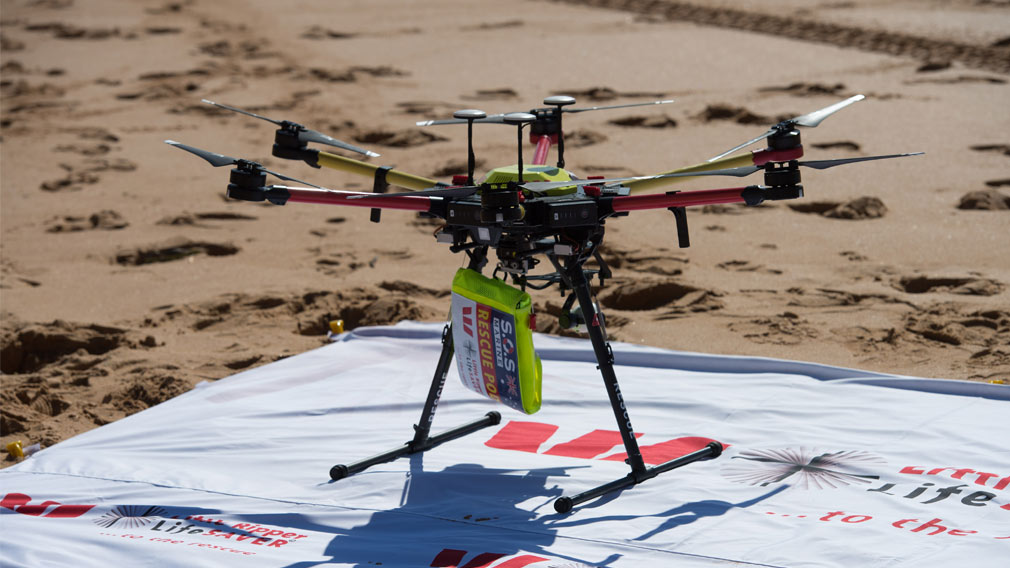Behind Little Ripper’s big journey

Westpac Little Ripper drones are operating at 11 NSW beaches. (Supplied)
On an otherwise ordinary day in late 2015, Kevin Weldon walked into Brian Hartzer’s office at the bank’s Kent Street, Sydney headquarters.
A decade since Weldon dreamt up using “unmanned aerial vehicles”, or drones, for shark spotting and search and rescue on Australia’s beaches, he was eager to secure support for his brainchild, Little Ripper Lifesaver. It appears a slightly unusual meeting – a bank sitting down with a small company founded by Weldon, the first president of the International Lifesaving Federation, and Paul Scully-Power AM, the first Australian-born person to journey into space.
Westpac, however, had history in the space through its 42-year sponsorship of the Westpac Life Saver Rescue Helicopter Service. And Hartzer, the bank’s chief executive officer, was already keen on Weldon’s idea of using of long-range drones for shark spotting after previously meeting the 84-year old at a Westpac helicopter ball and then being given a demo.
It was a major moment for Weldon, who came up with the concept in New Orleans in 2005 when seeing a drone searching for survivors in the aftermath of hurricane Katrina.
“The aim…(is) to accomplish things with search and rescue that were impossible to even dream about 10 or 20 years ago,” Mr Weldon, a businessman, aviator and philanthropist, said of the trials at the time.
On Thursday this week, his persistence paid dividends when a Westpac Little Ripper drone helped save two teenage boys in wild surf at Lennox Head beach, about 750 kilometres north of Sydney, by dropping a “rescue pod”, which self-inflated once hitting the water.
The dramatic rescue at around 11:30am (AEDT) involved two people on the beach, Surf Life Saving NSW’s Jai Sheridan flying the drone and a Westpac Little Ripper senior trainer, marking what is believed to be the first time globally a drone was involved in an ocean rescue.
Noel Purcell, a director of Little Ripper who previously worked at Westpac, said it was unique because there were no other lifesaving services on the beach at the time.
“It was just fortuitous because training was being undertaken and the drone was actually out in operation,” he told Westpac Wire. He noted it added to the many other lives potentially saved by being alerted of nearby sharks, building on the thousands of lives saved by the Westpac rescue helicopter service, including his own brother.
Despite some lingering cautiousness in some surf lifesaving circles around the use of drones, momentum was already building prior to this week’s events. Marcus Blackmore, the chairman of vitamins company Blackmores and a friend of Weldon’s, late last year donated a $50,000 Little Ripper drone to Bilgola surf club on Sydney’s northern beaches. In December, the NSW government, which in recent years has been seeking ways to reduce shark attacks, announced it would invest $430,000 in drone technology as part of a trial on the north coast, including training of lifesavers.
Mr Hartzer says he was proud Westpac was taking part in a “new generation of rescue”.
“Our involvement in Little Ripper might have seemed slightly out of the ordinary for a bank, but its impact is anything but -- the events at Lennox Head this week prove just that,” he says. “I saw this is innovation at its best that will lead to a safer Australia. It brings to life how innovative thinking, technology, and our corporate dedication to supporting Australia can combine to improve (and save!) lives.”
Mr Purcell says Little Ripper – named by Weldon, the publisher of the first edition of the Macquarie Dictionary in 1981 -- had more work to do around education of drones in surf lifesaving and scaling the business, but would not be where it was without original support from Westpac. The Little Ripper drones are operating at 11 NSW beaches, nine with surveillance and two with rescue capability.
“It takes great foresight to put sponsorship dollars, financial support, into what at the time was not yet a proven technology. Now it’s a world first,” Purcell says.
Westpac Little Ripper chief executive Eddie Bennet says the rescue was the result of three years of drone technology development.



